Water Resources of the Black Sea Catchment under Future Climate and Landuse Change Projections
Abstract
:1. Introduction
2. Material and Methods
2.1. Study Area
2.2. Soil Water Assessment Tool (SWAT)
2.3. Landuse Scenarios
2.4. Climate Change Scenarios
2.5. Model Setup, Calibration, and Validation
3. Results and Discussion
3.1. Temperature and Precipitation in a Changing Climate
3.2. Fresh Water Resources under Changing Landuse and Climate
3.3. Extreme Events
4. Summary
Acknowledgments
Author Contributions
Conflicts of Interest
References
- IPCC. Managing the Risks of Extreme Events and Disasters to Advance Climate Change Adaptation; A Special Report of Working Groups I and II of the Intergovernmental Panel on Climate Change; Field, C.B., Ed.; Cambridge University Press: Cambridge, UK; New York, NY, USA, 2012; p. 582. [Google Scholar]
- Vaghefi, S.A.; Mousavi, S.J.; Abbaspour, K.C.; Srinivasan, R.; Yang, H. Analyses of the impact of climate change on water resources components, drought and wheat yield in semiarid regions: Karkheh River Basin in Iran. Hydrol. Proc. 2014, 28, 2018–2032. [Google Scholar] [CrossRef]
- Krysanova, V.; Wortmann, M.; Bolch, T.; Merz, B.; Duethmann, D.; Walter, J.; Huang, S.; Tong, J.; Buda, S.; Kundzewicz, Z.W. Analysis of current trends in climate parameters, river discharge and glaciers in the Aksu River basin (Central Asia). Hydrol. Sci. J. 2015, 60, 566–590. [Google Scholar] [CrossRef]
- Giorgi, F.; Lionello, P. Climate change projections for the Mediterranean region. Glob. Planet. Chang. 2008, 63, 90–104. [Google Scholar] [CrossRef]
- Giorgi, F. Climate change Hot-spots. Geophys. Res. Lett. 2006, 33, L08707. [Google Scholar] [CrossRef]
- Ulbrich, U.; May, W.; Li, L.; Lionello, P.; Pinto, J.G.; Somot, S. The Mediterranean climate change under global warming. Dev. Earth Environ. Sci. 2006, 4, 399–415. [Google Scholar]
- Hattermann, F.F.; Weiland, M.; Huang, S.; Krysanova, V.; Kundzewicz, Z.W. Model-Supported Impact Assessment for the Water Sector in Central Germany Under Climate Change—A Case Study. Water Resour. Manag. 2011, 25, 3113–3134. [Google Scholar] [CrossRef]
- Christensen, J.H.; Christensen, O.B. Climate modeling: Severe summertime flooding in Europe. Nature 2003, 421, 805–806. [Google Scholar] [CrossRef] [PubMed]
- Semmler, T.; Jacob, D. Modeling extreme precipitation events—A climate change simulation for Europe. Glob. Planet. Chang. 2004, 44, 119–127. [Google Scholar] [CrossRef]
- Deque, M.; Jones, R.G.; Wild, M.; Giorgi, F.; Christensen, J.H.; Hassell, D.C.; Vidale, P.L.; Rockel, J.B.D.; Kjellstrom, E.; Castro, M.D.; et al. Global high resolution vs. regional climate model climate change scenarios over Europe: Quantifying confidence level from PRUDENCE results. Clim. Dyn. 2005, 25, 653–670. [Google Scholar] [CrossRef]
- Myroshnychenko, V.; Ray, N.; Lehmann, A.; Giuliani, G.; Kideys, A.; Weller, P.; Teodor, D. Environmental data gaps in Black Sea catchment countries: INSPIRE and GEOSS State of Play. Environ. Sci. Policy 2015, 46, 13–25. [Google Scholar] [CrossRef]
- Schneider, C.; Laizé, C.L.R.; Acreman, M.C.; Flörke, M. How will climate change modify river flow regimes in Europe? Hydrol. Earth Syst. Sci. 2013, 17, 325–339. [Google Scholar] [CrossRef] [Green Version]
- Aus der Beek, T.; Menzel, L.; Rietbroek, R.; Fenoglio-Marc, L.; Grayek, S.; Becker, M.; Kusche, J.; Stanev, E.V. Modeling the water resources of the Black and Mediterranean Sea river basins and their impact on regional mass changes. J. Geodyn. 2012, 59, 157–167. [Google Scholar] [CrossRef]
- Engeland, K.; Hisdal, H. A Comparison of Low Flow Estimates in Ungauged Catchments Using Regional Regression and the HBV-Model. Water Resour. Manag. 2009, 23, 2567–2586. [Google Scholar] [CrossRef]
- Farjad, B.; Gupta, A.; Marceau, D.J. Annual and Seasonal Variations of Hydrological Processes under Climate Change Scenarios in Two Sub-Catchments of a Complex Watershed. Water Resour. Manag. 2016, 30, 2851–2865. [Google Scholar] [CrossRef]
- Arnold, J.G.; Srinivasan, R.; Muttiah, R.S.; Williams, J.R. Large area hydrologic modeling and assessment—Part 1: Model development. J. Am. Water Resour. Assess. 1998, 34, 73–89. [Google Scholar] [CrossRef]
- Ndomba, P.; Mtalo, F.; Killingtveit, A. SWAT model application in a data scarce tropical complex catchment in Tanzania. Phys. Chem. Earth 2008, 33, 626–632. [Google Scholar] [CrossRef]
- IMAGE. The IMAGE 2.2 Implementation of the SRES Scenarios: A Comprehensive Analysis of Emissions, Climate Change and Impacts in the 21st Century; RIVM CD-ROM Publication 481508018; National Institute of Public Health and the Environment RIVM: Bilthoven, The Netherlands, 2001. [Google Scholar]
- Rouholahnejad, E.; Abbaspour, K.C.; Bacu, V.; Lehmann, A. Water resources of the Black Sea Basin at high spatial and temporal resolution. Water Resour. Res. 2014, 50, 5866–5885. [Google Scholar] [CrossRef]
- Black Sea Investment Facility (BSEI). Review of the Black Sea Environmental Protection Activities. General Review; Black Sea Investment Facility (BSEI): Brussels, Belgium, 2005. [Google Scholar]
- Tockner, K.; Uehlinger, U.; Robinson, C.T. Rivers of Europe; Academic Press, Elsevier: San Diego, CA, USA, 2009; ISBN 978-0-12-369449-2. [Google Scholar]
- NASA. Land Processes Distributed Active Archive Center (LP DAAC), ASTER L1B, USGS/Earth Resour. Obs. and Sci. Cent.; Sioux Falls, South Dakota. 2001. Available online: http://lpdaac.usgs.gov (accessed on 12 August 2012).
- Neitsch, S.L.; Arnold, J.G.; Kiniry, J.R.; Williams, J.R. Soil and Water Assessment Tool Theoretical Documentation Version 2009; Texas Water Resources Institute Technical Report No. 406; Texas A&M University System: College Station, YX, USA, 2009. [Google Scholar]
- Williams, J.R. Flood routing with variable travel time or variable storage coefficients. Trans. Am. Soc. Agric. Eng. 1969, 121, 100–103. [Google Scholar] [CrossRef]
- Lehmann, A.; Giuliani, G.; Mancosu, E.; Abbaspour, K.C.; Sözen, S.; Gorgan, D.; Beel, A.; Ray, N. Filling the gap between Earth observation and policy making in the Black Sea catchment with enviroGRIDS. Environ. Sci. Policy 2015, 46, 1–12. [Google Scholar] [CrossRef]
- United Nation (UN). World Population and Urbanization Prospects; UN: New York, NY, USA, 2011; p. 302. [Google Scholar]
- RIKS. Metronamica–Model Descriptions; Research Institute for Knowledge Systems: Maastricht, The Netherlands, 2011. [Google Scholar]
- Mancosu, E.; Gago-Silva, A.; Barbosa, A.; de Bono, A.; Ivanov, E.; Lehmann, A.; Fons, J. Future landuse change scenarios for the Black Sea catchment. Environ. Sci. Policy 2015, 46, 26–36. [Google Scholar] [CrossRef]
- Fowler, H.J.; Blenkinsop, S.; Tebaldi, C. Linking climate change modelling to impacts studies: Recent advances in downscaling techniques for hydrological modelling. Int. J. Climatol. 2007, 27, 1547–1578. [Google Scholar] [CrossRef]
- Climatic Research Unit (CRU). CRU Time Series (TS) High Resolution Gridded Datasets, University of East Anglia Climatic Research Unit (CRU), NCAS British Atmospheric Data Centre. 2008. Available online: http://catalogue.ceda.ac.uk/uuid/3f8944800cc48e1cbc29a5ee12d8542d (accessed on 8 April 2011).
- Gago Da Silva, A.; Gunderson, I.; Goyette, S.; Lehmann, A. Delta-Method Applied to the Temperature and Precipitation Time Series-An Example. enviroGRIDS FP7 Project, Report Number D3.6. 2012. Available online: http://archive-ouverte.unige.ch/unige:34235 (accessed on 1 March 2012).
- Abbaspour, K.C.; Rouholahnejad, E.; Vaghefi, S.; Srinivasan, R.; Klöve, B. Modelling hydrology and water quality of the European Continent at a subbasin scale: Calibration of a high-resolution large-scale SWAT model. J. Hydrol. 2015, 524, 733–752. [Google Scholar] [CrossRef]
- Jarvis, A.; Reuter, H.I.; Nelson, A.; Guevara, E. Hole-Filled SRTM for the Globe Version 4, Data Access: The CGIAR-CSI SRTM 90m Database. 2008. Available online: http://srtm.csi.cgiar.org (accessed on 3 March 2012).
- Mitchell, T.D.; Jones, P.D. An improved method of constructing a database of monthly climate observations and associated high-resolution grids. Int. J. Climatol. 2005, 25, 693–712. [Google Scholar] [CrossRef]
- Weedon, G.P.; Gomes, S.; Viterbo, P.; Shuttleworth, W.J.; Blyth, E.; Österle, H.; Adam, J.C.; Bellouin, N.; Boucher, O.; Best, M. Creation of the WATCH Forcing data and its use to assess global and regional reference crop evaporation over land during the twentieth century. J. Hydrometeorol. 2011, 12, 823–848. [Google Scholar] [CrossRef]
- EEA Catchments and Rivers Network System v1.1 (ECRINS). Rationales, Building and Improving for Widening Uses to Water Accounts and WISE Applications; Publications Office of the European Union: Luxembourg, 2012; ISBN 978-92-9213-320-7. [Google Scholar]
- Food and Agricultural Organization (FAO). The Digital Soil Map of the World and Derived soil Properties; CD-ROM, Version 3.5; Food and Agriculture Organization of the United Nations, Land and Water Development Division: Rome, Italy, 2003. [Google Scholar]
- Portmann, F.T.; Siebert, S.; Döll, P. MIRCA2000 Global monthly irrigated and rainfed crop areas around the year 2000: A new high resolution data set for agricultural and hydrological modeling. Glob. Biochem. Cycle 2010, 24, GB1011. [Google Scholar] [CrossRef]
- Monfreda, C.; Ramankutty, N.; Foley, J.A. Farming the planet: 2. Geographic distribution of crop areas, yields, physiological types, and net primary production in the year 2000. Glob. Biogeochem. Cycles 2008, 22, GB1022. [Google Scholar] [CrossRef]
- Global Runoff Data Centre (GRDC). Long-Term Mean Monthly Discharges and Annual Characteristics of GRDC Station/Global Runoff Data Centre; Federal Institute of Hydrology (BfG): Koblenz, Germany, 2011. [Google Scholar]
- Falkenmark, M.; Rockström, J. The new blue and green water paradigm: Breaking new ground for water resources planning and management. J. Water Resour. Plan. Manag. ASCE 2006, 132, 129–132. [Google Scholar] [CrossRef]
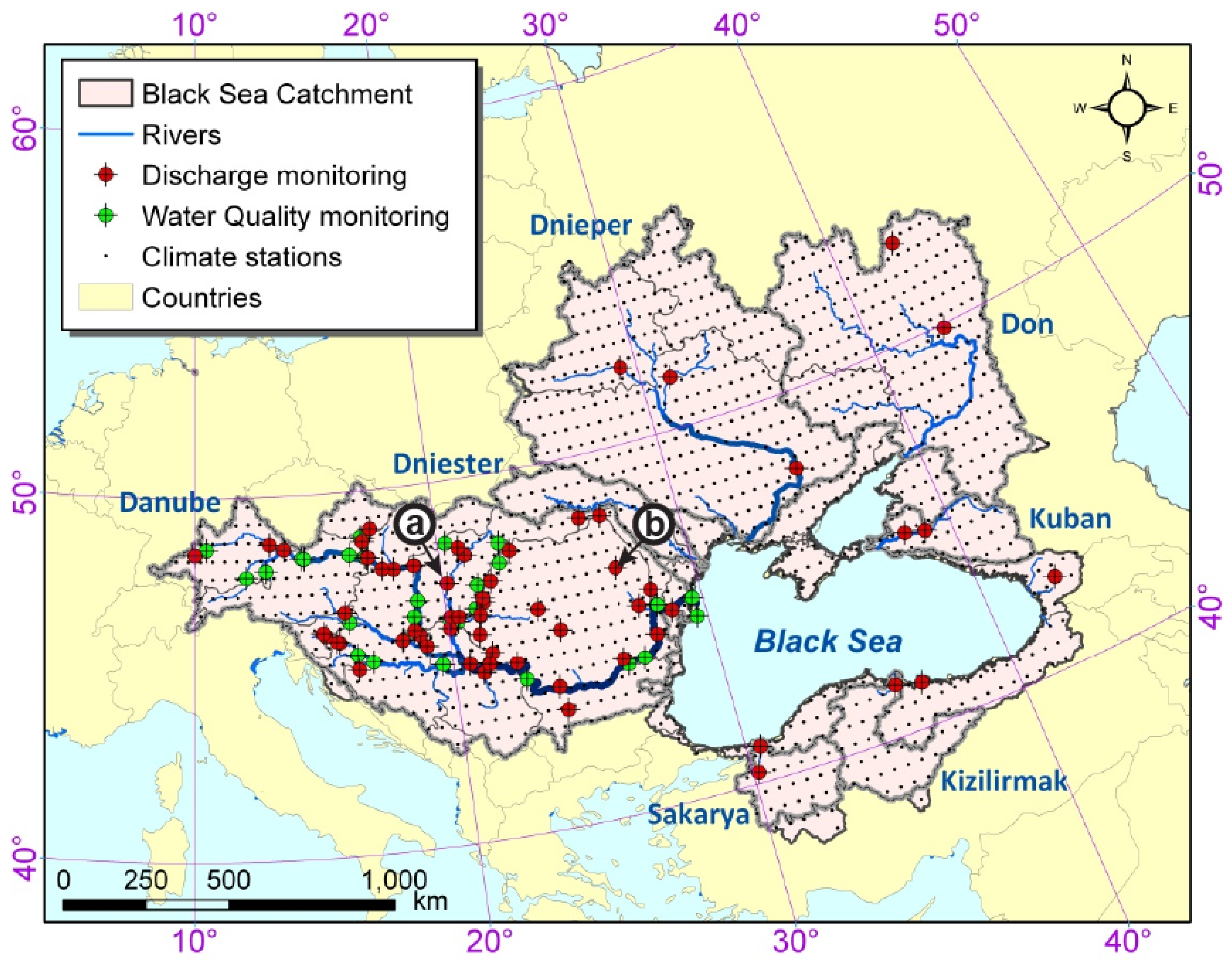
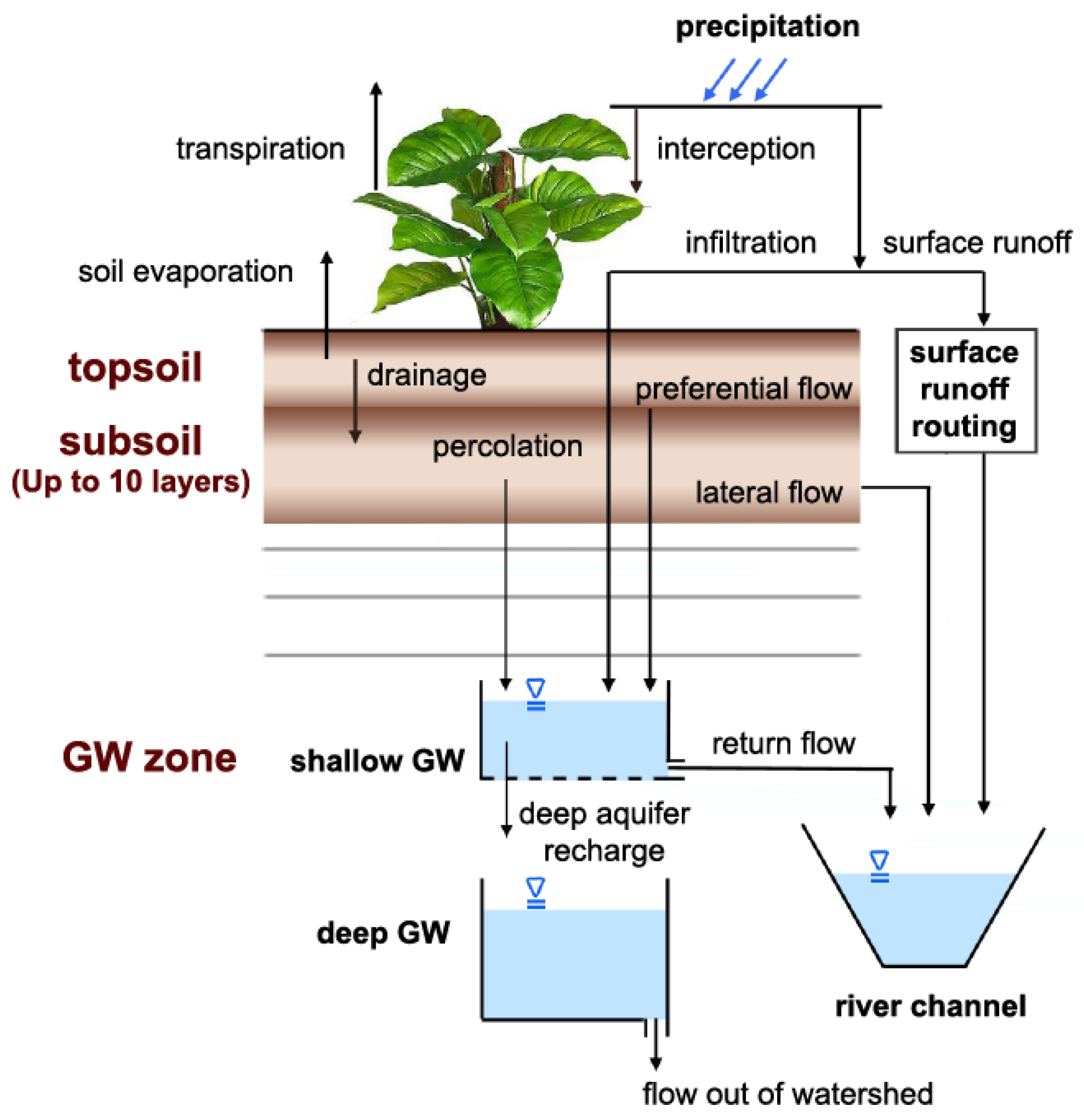

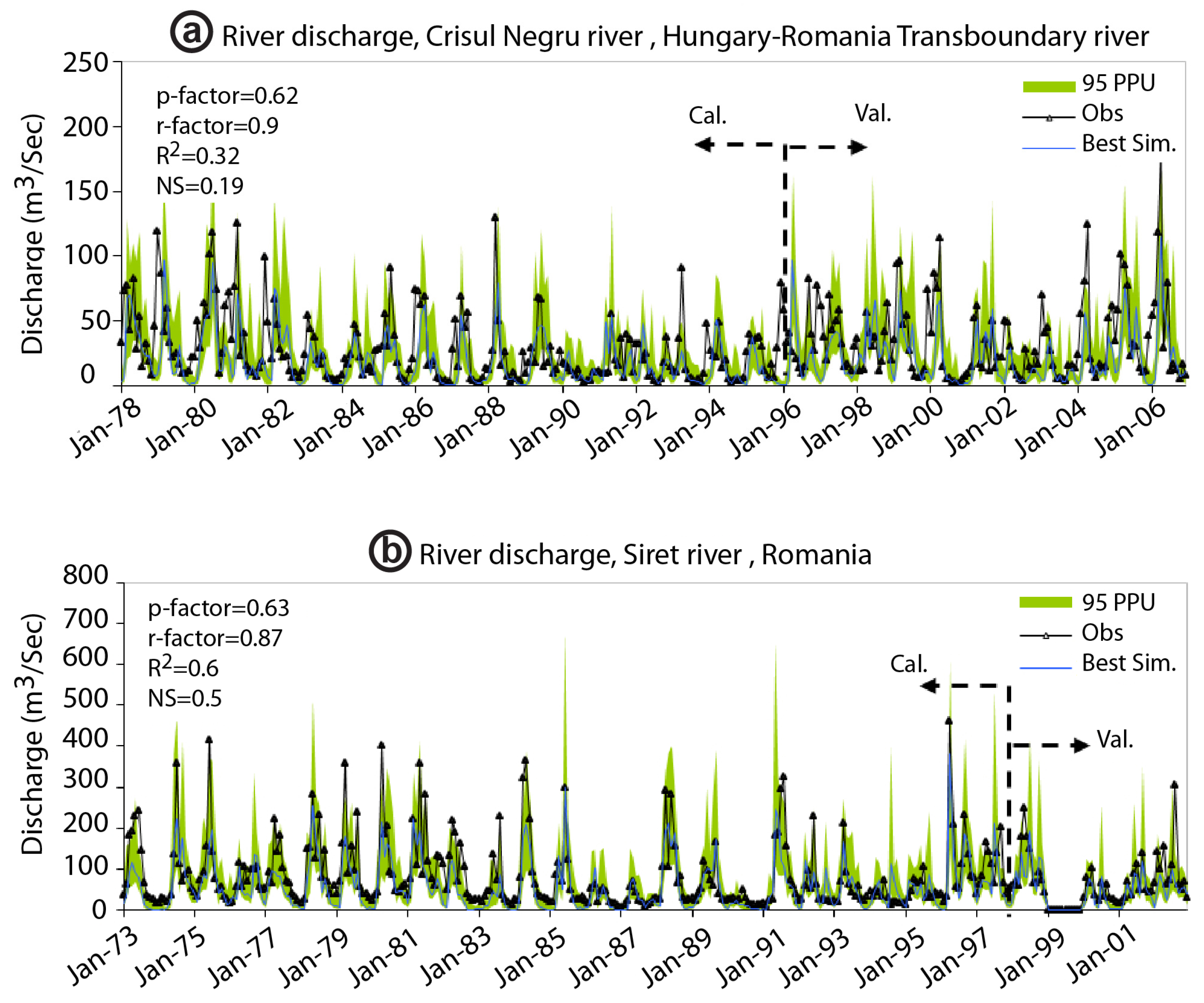
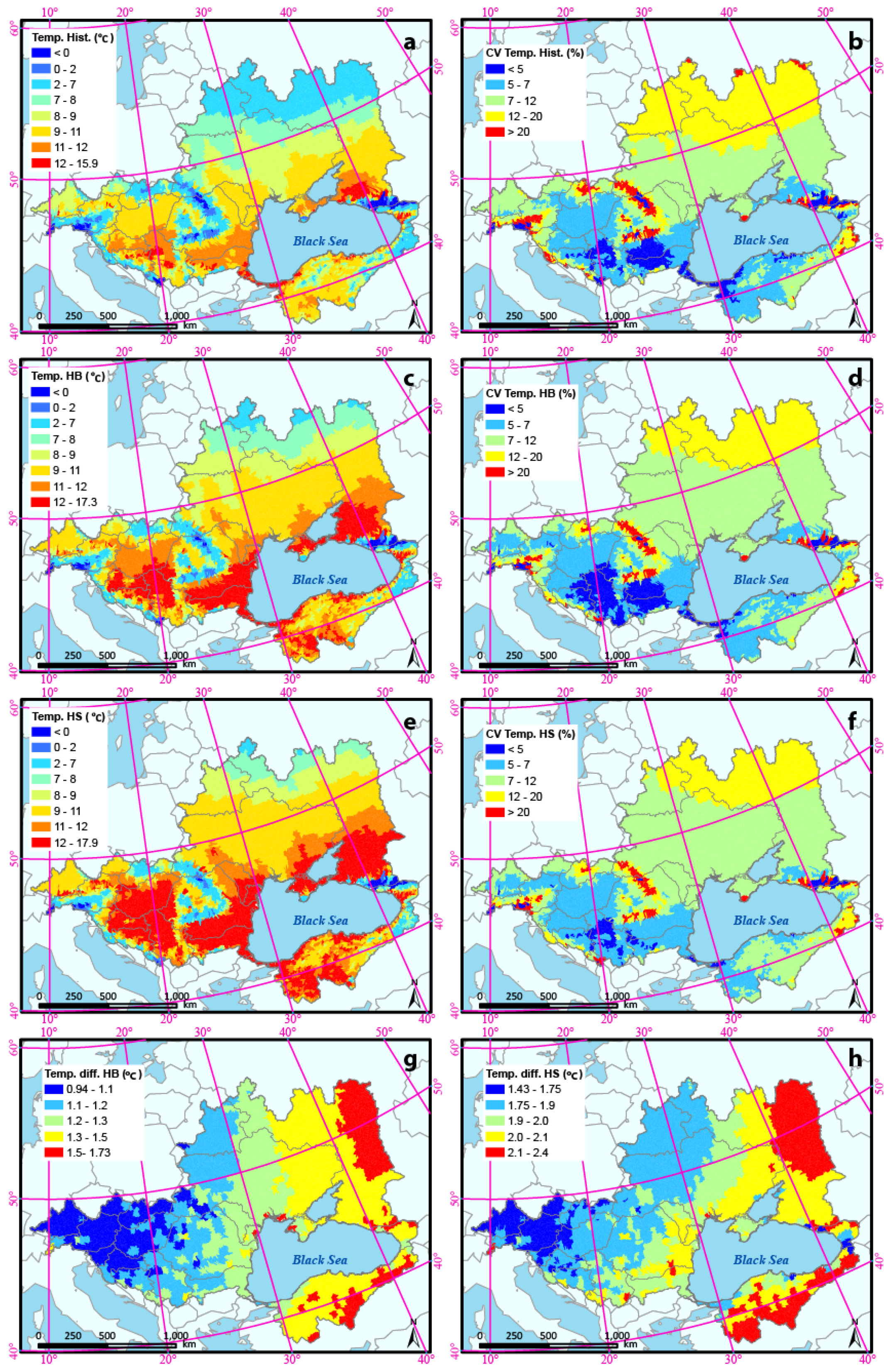
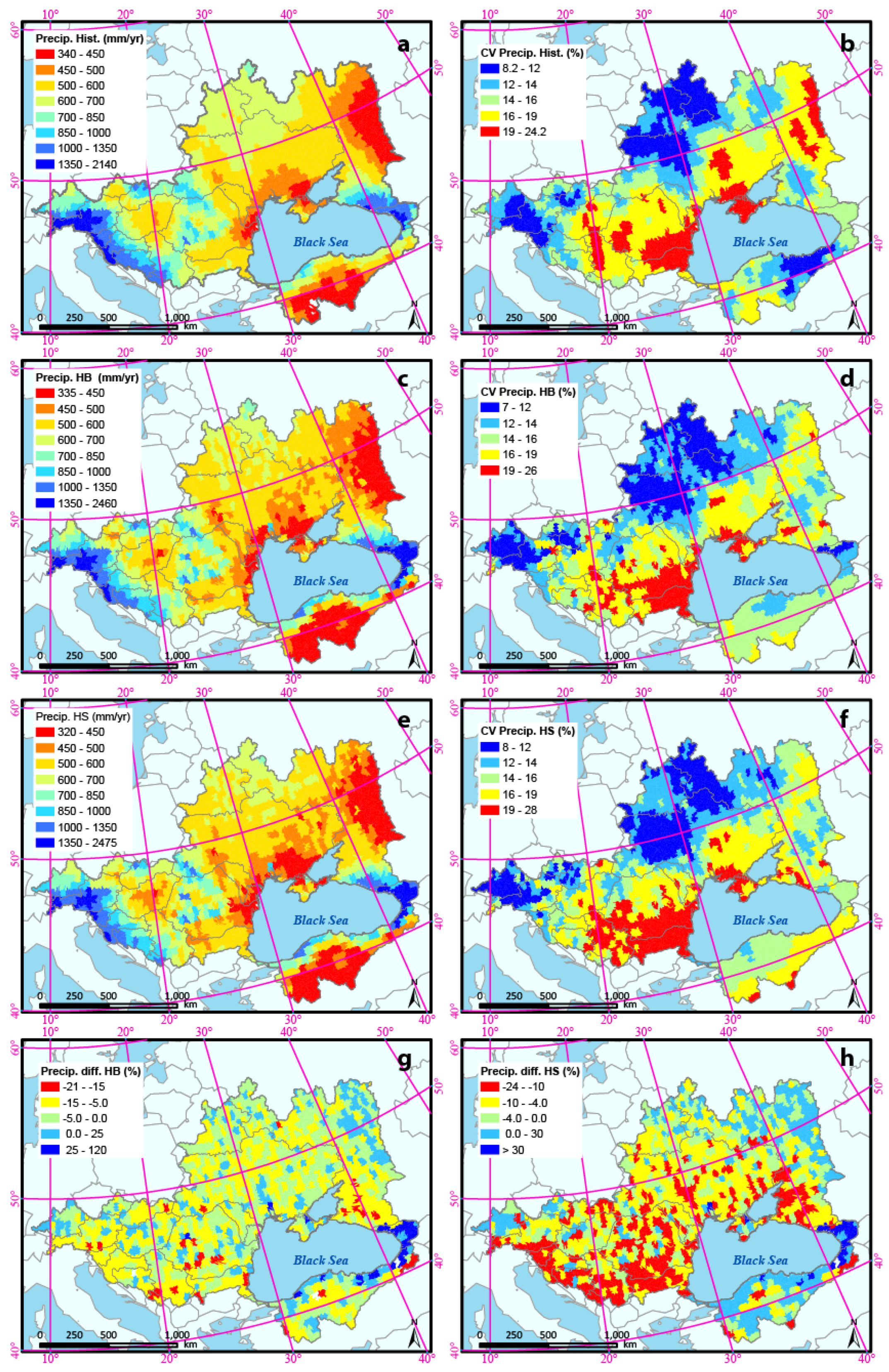

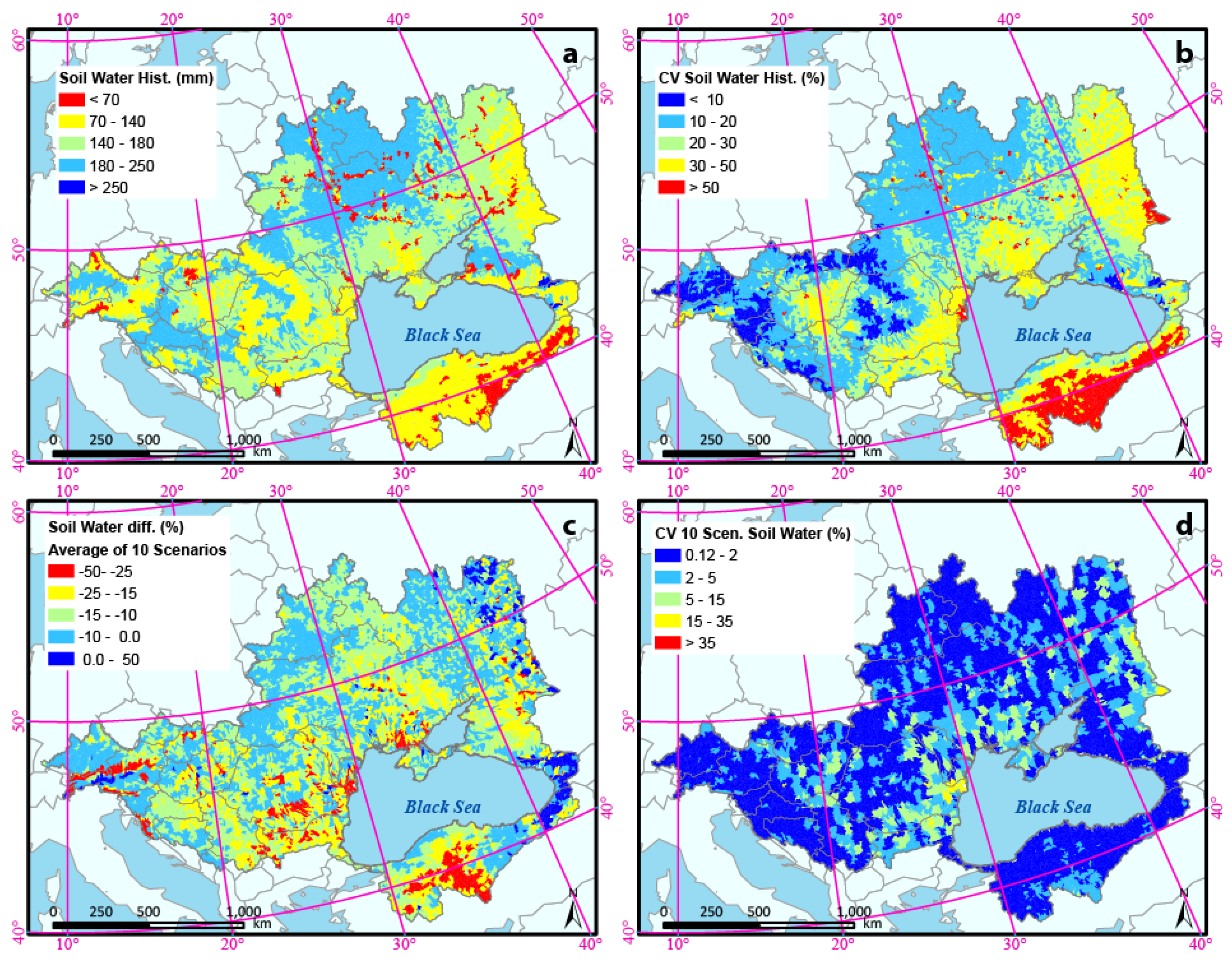
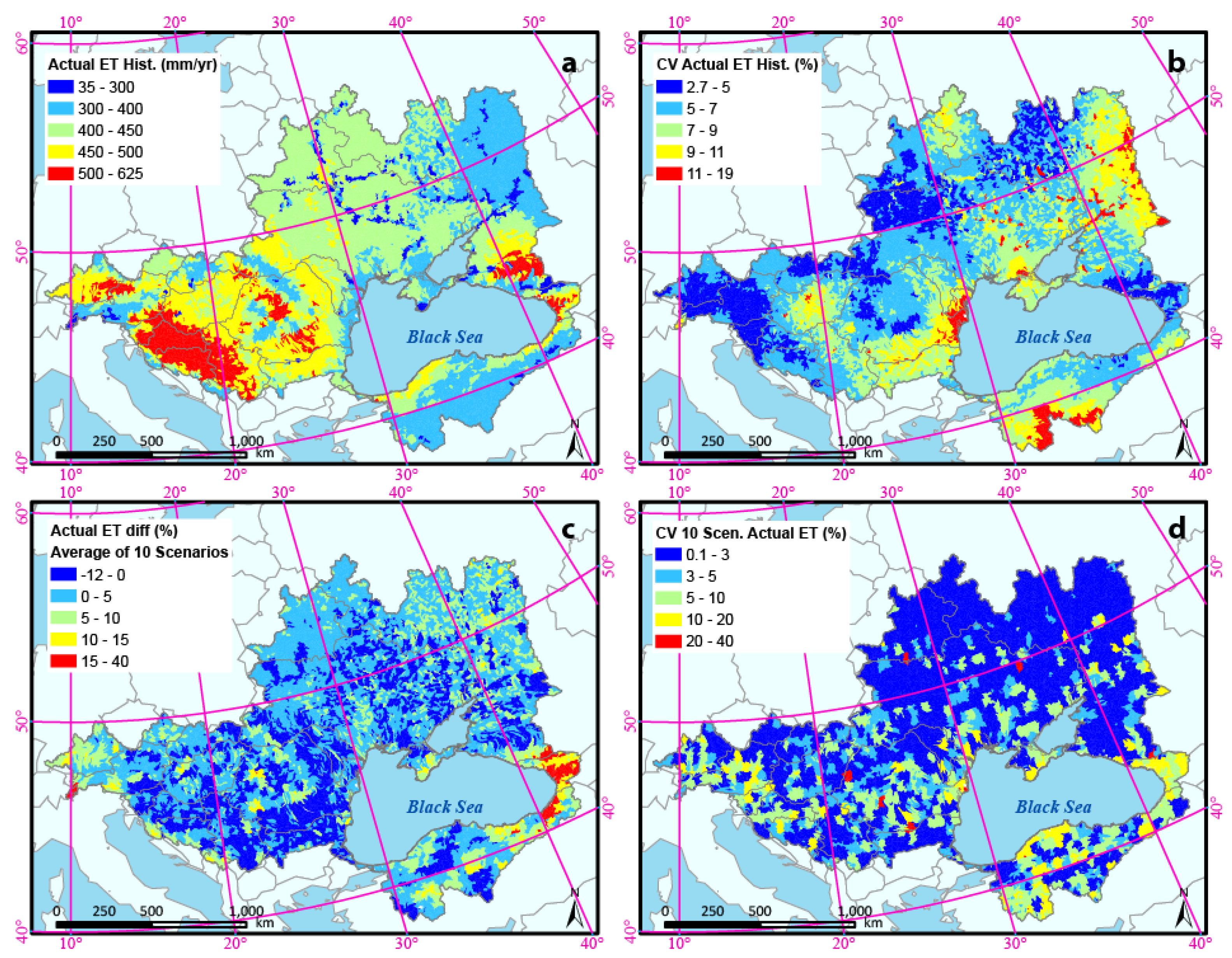
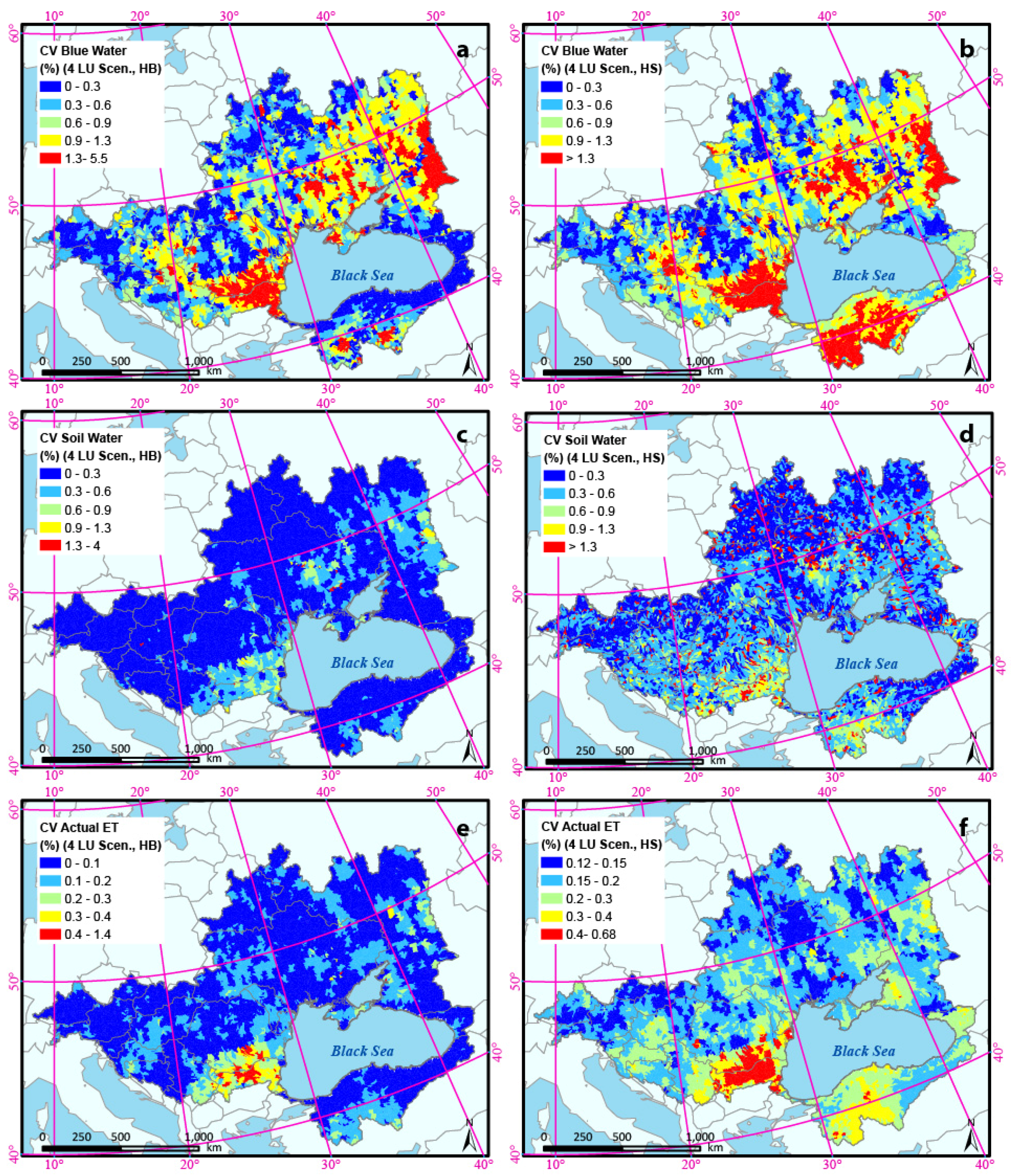

| Landuse Scenarios | ||||
|---|---|---|---|---|
| Driving Forces | BS HOT | BS ALONE | BS COOP | BS COOL |
| Population growth | low | very high | low | medium |
| Urban population | increase | increase | slight increase | slight increase |
| GDP growth | very high | slow | high | medium |
| Forest area | increase | decrease | increase | decrease |
| Grassland area | increase | decrease | increase | decrease |
| Cropland area | increase | increase | decrease | increase |
| Built-up area | increase | increase | increase | stable |
| Protected areas | stable | stable | increase | stable |
| Climate change | high | high | lower | low |
| Type | Source | Description |
|---|---|---|
| DEM | SRTM [33] | 90 m resolution extracted for BSC |
| Climate | CRU [30,34], Solar Radiation [35] | 0.5° resolution gridded climate data, daily temperature (min.; max.), daily precipitation (1970–2006) daily global solar radiation from 6110 virtual stations (1970–2006) |
| River | ECRINS [36] | 30 m resolution, from European Catchments and Rivers Network System (ECRINS) |
| Soil | FAO [37] | 5 km resolution, from FAO-UNESCO global soil map, provides data for 5000 soil types comprising two layers (0–30 cm and 30–100 cm depth) |
| Landuse | MODIS [22] | 500 m resolution, by the NASA Land Processes Distributed Active Archive Center (LP DAAC) at the USGS/Earth Resources Observation and Science Center (EROS) |
| Management | MIRCA2000 [38], McGill yields data [39] | 5 arc min resolution cropping area and the start and end month of cropping periods, 5 arc min crop yield of three major crop (Wheat, Cory, Barely) |
| River discharge | GRDC [40] | 144 Monthly river discharge data (1970–2006) |
| Processes/Components | Method |
|---|---|
| Evapotranspiration | Hargreaves |
| Surface runoff | Soil Conservation Service (SCS) curve number |
| Erosion | Modified universal soil loss equation |
| Lateral flow | Kinematic storage model |
| Groundwater flow | Steady-state response from shallow aquifer |
| Stream flow routing | Variable storage routing |
| Parameter Name | Definition |
|---|---|
| CN2.mgt | SCS runoff curve number for moisture condition II |
| ALPHA_BF.gw | Base flow alpha factor (days) |
| GW_DELAY.gw | Groundwater delay time (days) |
| GWQMN.gw | Threshold depth of water in shallow aquifer for return flow (mm) |
| GW_REVAP.gw | Groundwater revap. coefficient |
| REVAPMN.gw | Threshold depth of water in the shallow aquifer for ‘revap’ (mm) |
| RCHRG_DP.gw | Deep aquifer percolation fraction |
| CH_N2.rte | Manning’s n value for main channel |
| CH_K2.rte | Effective hydraulic conductivity in the main channel (mm h−1) |
| ALPHA_BNK.rte | Baseflow alpha factor for bank storage (days) |
| SOL_AWC().sol | Soil available water storage capacity (mm H2O/mm soil) |
| SOL_K().sol | Soil conductivity (mm h−1) |
| SOL_BD().sol | Soil bulk density (g cm−3) |
| OV_N.hru | Manning’s n value for overland flow |
| HRU_SLP.hru | Average slope steepness (m m−1) |
| SLSUBBSN.hru | Average slope length (m) |
| SFTMP().sno | Snowfall temperature (°C) |
| SMTMP().sno | Snow melt base temperature (°C) |
| SMFMX().sno | Maximum melt rate for snow during the year (mm °C−1 day−1) |
| SMFMN().sno | Minimum melt rate for snow during the year (mm °C−1 day−1) |
© 2017 by the authors. Licensee MDPI, Basel, Switzerland. This article is an open access article distributed under the terms and conditions of the Creative Commons Attribution (CC BY) license (http://creativecommons.org/licenses/by/4.0/).
Share and Cite
Rouholahnejad Freund, E.; Abbaspour, K.C.; Lehmann, A. Water Resources of the Black Sea Catchment under Future Climate and Landuse Change Projections. Water 2017, 9, 598. https://doi.org/10.3390/w9080598
Rouholahnejad Freund E, Abbaspour KC, Lehmann A. Water Resources of the Black Sea Catchment under Future Climate and Landuse Change Projections. Water. 2017; 9(8):598. https://doi.org/10.3390/w9080598
Chicago/Turabian StyleRouholahnejad Freund, Elham, Karim C. Abbaspour, and Anthony Lehmann. 2017. "Water Resources of the Black Sea Catchment under Future Climate and Landuse Change Projections" Water 9, no. 8: 598. https://doi.org/10.3390/w9080598





